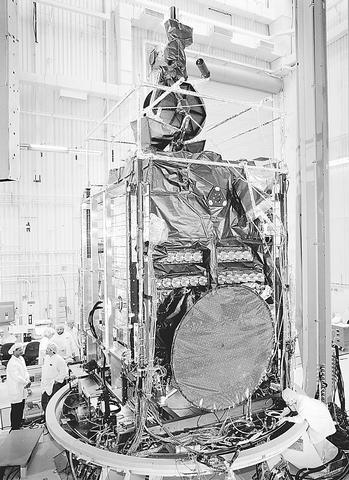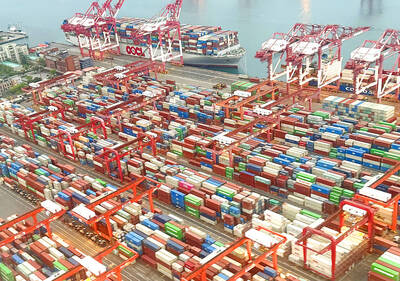It has been a little more than a week since EchoStar Communications made an unsolicited US$30 billion offer for the DirecTV satellite television unit of Hughes Electronics.
And General Motors, Hughes' owner, has said only that it will consider the bid -- while also continuing to negotiate a pending deal between Hughes and the News Corp.
The two suitors may be focusing mainly on DirecTV's 10 million subscribers and US$5 billion in revenue. But no matter who ends up owning DirecTV, Hughes is proceeding with a plan to launch the DirecTV 4S satellite, designed to more than double DirecTV's channel capacity -- to 750 from about 320 now.

PHOTO: NY TIMES
Just as important, special spot-beam antennas on the new spacecraft will be able to aim signals so precisely at many of the nation's largest cities that many more local television stations can be efficiently added to the satellite service.
As a result, metropolitan areas like New York and Los Angeles will have all local broadcast stations available by satellite, up from the current handfuls of local stations carried by satellite in those cities.
"This has been one of the things where we haven't been able to compete as well against cable," said James Butterworth, vice president for communications systems engineering at DirecTV.
And yet, even with 465 channels on the new satellite dedicated to rebroadcasting local signals, DirecTV will still fall well short of carrying all 1,500 local broadcast stations in the US. And in some ways, DirecTV is expanding its local lineup only under duress.
The new satellite is meant to let DirecTV meet the Satellite Home Viewer Improvement Act's "must carry" rules. Under federal law, which was passed in 1999 and takes effect in January, if a satellite service delivers even one local channel in a market, the service must begin carrying all the other local channels as well.
In New York, for example, DirecTV currently transmits the signals of the local affiliates of the six commercial broadcast networks. Assuming the new satellite is successfully launched, DirecTV would begin offering its metropolitan New York viewers up to 20 local broadcast signals.
Based on the markets in which DirecTV currently rebroadcasts at least one local station, the company will be expanding its local-channel offerings in 41 markets, which account for 60 percent of the nation's population.
DirecTV will spend more than US$200 million on DirecTV 4S, including launching costs and insurance. The satellite, which will be sent into orbit by the European launching company Arianespace, has five large antennas designed to transmit spot beams -- the signals that will be aimed at 26 tightly defined areas on the ground. Such beams are a first for satellite TV. Because they do not overlap, the beams' radio frequencies can be reused to carry local signals in different markets.
Currently, DirecTV operates five satellites, all 22,300 miles over the equator. Three are in an orbital slot at 101 degrees west longitude, one is at 110 degrees, and the other is at 119 degrees. The new satellite, built by Boeing Satellite Systems, will be positioned alongside the three satellites currently parked at 101 degrees.
With DirecTV's existing satellites, the beams are broad. So the frequencies now used for transmitting the six local New York stations -- signals that only the receivers of DirecTV subscribers in New York can unscramble -- are worthless for the rest of country. The new spot beams will overcome that inefficiency.
"By focusing over a very small area, like the New York City metropolitan area, you can reuse the frequency in several other places, like Miami, San Francisco and Chicago," Butterworth said. "So we've increased our capacity substantially."
In addition to the 26 beams focused on the largest 41 TV markets, the new satellite also has a conventional antenna beam that would cover the entire US.
While the new spacecraft is meant to let DirecTV meet the requirements of the new law, the consumer value of expanding local broadcast channels beyond the major network affiliates is debatable.
"I don't think that going from four to five channels to 20 is very relevant to most customers; the viewership on those smaller channels tends to be tiny," said Armand Musey, Salomon Smith Barney's satellite analyst. "This is why the satellite industry is fighting the `must carry' rules so hard."
Indeed, even as it prepares to meet the law's requirements, DirecTV is challenging the law in court, along with the industry's trade group, the Satellite Broadcasting and Communications Association. Also taking part in legal fight is DirecTV's suitor, EchoStar, the No. 2, satellite TV company.
EchoStar, operator of the Dish satellite TV network, has six satellites in orbit in four orbital locations. The network can transmit more than 600 channels of TV and music, and carries at least some local broadcast signals in 36 markets. The company is planning to use spot beams on spacecraft that are to be launched later this year and in 2002, although EchoStar has not yet disclosed the specifics of its local broadcasting plans.
Before the 1999 must-carry law was passed, satellite TV companies could not carry local stations for delivery into the stations' home markets. After the law allowed DirecTV and EchoStar began offering the most popular local stations in the major markets in 2000, DirecTV's subscriptions rose to 10 million currently, from 8 million at the end of 1999. EchoStar's Dish Network's subscriptions rose to 6 million, from 3.4 million at the end of 1999.
"The No. 1 thing in DBS when customers choose is being able to get local programming," said Robert Peck, a satellite analyst at Bear, Stearns. DBS refers to direct-broadcast satellite service. "That's why DBS had such a big boost in 2001."
Peck said the rate of growth for new subscribers had begun to slow, but predicted that DirecTV would have 16 million subscribers by 2007. And he said the new satellite's local coverage beams would be a key to retaining subscribers.
Rupert Murdoch's News Corp had been negotiating a merger with Hughes and DirecTV for a year before EchoStar's unsolicited offer created new uncertainties. Already a major player in international satellite TV, News Corp. sees DirecTV as a way to expand into the US while adding satellite TV to its collection of local TV stations, cable channels and Fox broadcast network.
The new satellite is not central to the proposed News Corp-Hughes merger. But it would fit with Murdoch's long-term strategy of providing local services by satellite and give him even more control over distribution of the programming he owns, according to Mickey Alpert, a consultant to the satellite and wireless industries.
"He owns Fox, and I expect that getting more Fox channels delivered into local areas is important to him," Alpert said.
As for EchoStar's offer, the main drawback has been the prospect of the deal's meeting resistance from Washington. Regulators might resist the formation of a company that would control about 90 percent of the nation's satellite television business. But EchoStar has argued that the satellite television business is simply a subset of the multichannel pay TV business, in which the cable industry is a far larger competitor.
By combining with DirecTV, EchoStar could also argue that the companies could make better use of the nation's satellite spectrum and orbital positions, which are allocated under treaty by the International Telecommunications Union and assigned and regulated by the Federal Communications Commission.
If the two merged, theoretically at least, their satellite systems could be combined and duplicative programming could be eliminated. The move might also free up enough spectrum to make 100 or more additional local TV stations available by satellite than either company currently plans to carry, according to Jimmy Schaeffler, a subscription TV analyst with the Carmel Group, a consulting firm in Carmel-by-the-Sea, California.
"If DirecTV and EchoStar could combine to carry a single set of signals on one satellite," he said, "DBS as an industry could do a much better job of competing with the US cable industry -- especially for the carriage of many, many more local channels to many smaller designated market areas."

SECURITY: As China is ‘reshaping’ Hong Kong’s population, Taiwan must raise the eligibility threshold for applications from Hong Kongers, Chiu Chui-cheng said When Hong Kong and Macau citizens apply for residency in Taiwan, it would be under a new category that includes a “national security observation period,” Mainland Affairs Council (MAC) Minister Chiu Chui-cheng (邱垂正) said yesterday. President William Lai (賴清德) on March 13 announced 17 strategies to counter China’s aggression toward Taiwan, including incorporating national security considerations into the review process for residency applications from Hong Kong and Macau citizens. The situation in Hong Kong is constantly changing, Chiu said to media yesterday on the sidelines of the Taipei Technology Run hosted by the Taipei Neihu Technology Park Development Association. With

CARROT AND STICK: While unrelenting in its military threats, China attracted nearly 40,000 Taiwanese to over 400 business events last year Nearly 40,000 Taiwanese last year joined industry events in China, such as conferences and trade fairs, supported by the Chinese government, a study showed yesterday, as Beijing ramps up a charm offensive toward Taipei alongside military pressure. China has long taken a carrot-and-stick approach to Taiwan, threatening it with the prospect of military action while reaching out to those it believes are amenable to Beijing’s point of view. Taiwanese security officials are wary of what they see as Beijing’s influence campaigns to sway public opinion after Taipei and Beijing gradually resumed travel links halted by the COVID-19 pandemic, but the scale of

TRADE: A mandatory declaration of origin for manufactured goods bound for the US is to take effect on May 7 to block China from exploiting Taiwan’s trade channels All products manufactured in Taiwan and exported to the US must include a signed declaration of origin starting on May 7, the Bureau of Foreign Trade announced yesterday. US President Donald Trump on April 2 imposed a 32 percent tariff on imports from Taiwan, but one week later announced a 90-day pause on its implementation. However, a universal 10 percent tariff was immediately applied to most imports from around the world. On April 12, the Trump administration further exempted computers, smartphones and semiconductors from the new tariffs. In response, President William Lai’s (賴清德) administration has introduced a series of countermeasures to support affected

Pope Francis is be laid to rest on Saturday after lying in state for three days in St Peter’s Basilica, where the faithful are expected to flock to pay their respects to history’s first Latin American pontiff. The cardinals met yesterday in the Vatican’s synod hall to chart the next steps before a conclave begins to choose Francis’ successor, as condolences poured in from around the world. According to current norms, the conclave must begin between May 5 and 10. The cardinals set the funeral for Saturday at 10am in St Peter’s Square, to be celebrated by the dean of the College